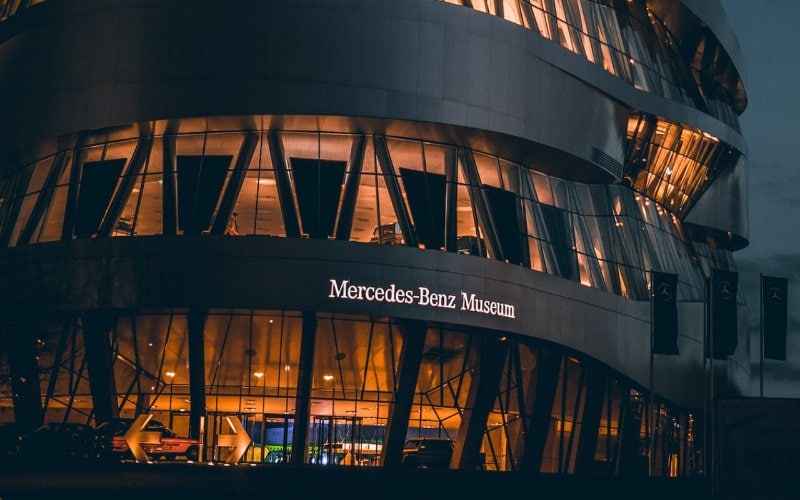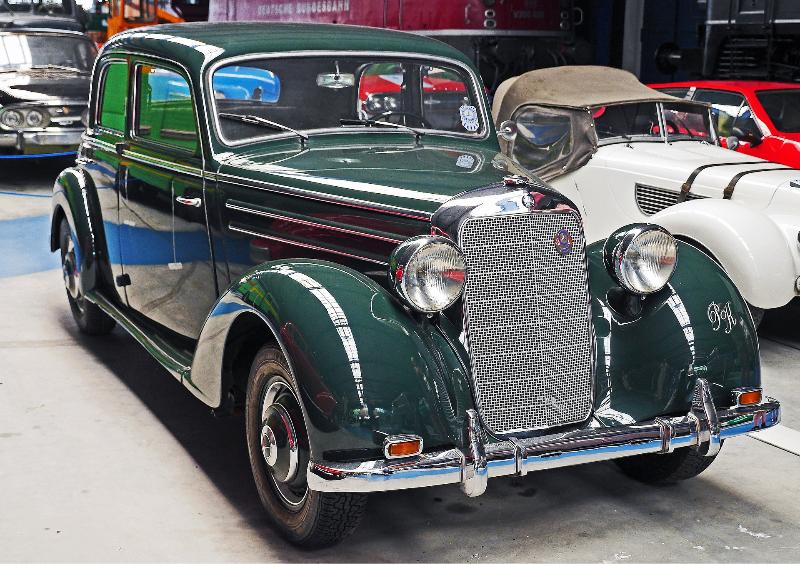When Was Mercedes Founded? Origin, History, & FAQ
-

- Last updated:

Mercedes-Benz is an automotive company that needs no introduction. It’s one of the most iconic car brands in the world, with an equally fascinating history. The car manufacturing giant is world-renowned for its sophistication, innovation, and luxury. But when was Mercedes founded?
Mercedes-Benz was founded in 1886 by German automotive pioneer Carl Benz, who called it the “Motorwagen.” Benz is also credited with the invention of the petrol-powered engine. He and his partner, Wilhelm Maybach, worked together to create a gasoline-powered car that ran on four wheels.
Here, we’ll look at the history of Mercedes, its milestones and growth, and how it has transformed over the years.
Who Founded Mercedes-Benz?

The Mercedes-Benz automobile was founded by Carl Friedrich Benz in 1886. Carl Benz was a German engine designer and automotive engineer who invented the internal combustion engine. Benz partnered with Wilhelm Maybach to create the first practical automobile, a gasoline-powered car that ran on four wheels.
History of Mercedes-Benz: The Early Years

The first Mercedes-Benz was unveiled at the 1886 Berlin Motor Show. The initial model, called the “Motorwagen,” was powered by a single-cylinder engine and had three wheels. Benz’s invention caught on quickly, and within a year, he had sold over 25 of these vehicles. Sixty miles away, Gottlieb Daimler was working on his own petrol-powered automobile, completely unaware of the work of his counterpart, Karl Benz.
In 1889, Daimler and Maybach created the first ever petrol-powered car with four wheels, which was essentially a petrol-powered stagecoach. The two then founded Daimler-Motoren-Gesellschaft, or DMG, in 1890 to sell their creations to the public. In 1891, Benz also created a petrol-powered four-wheeler, and by 1900, he was the world’s largest automaker.
All the buzz caught the attention of Australian entrepreneur, Emil Jenillek, who partnered with the two engineers to form Mercedes in 1901. They chose to name the company “Mercedes” after Jenillek’s daughter. Mercedes and DMG worked as separate entities until 1924 when the economic ramifications of World War I when ramifications of World War I forced the two companies to join forces to form Daimler-Benz AG.
The merger saw incredible success, and they started producing vehicles under the name Mercedes-Benz. By 1927, the company was producing 7,000 vehicles, instantly making them industry leaders. After the success of the Mercedes-Benz W15, the two engineers created a separate Mercedes-Benz division Daimler Benz AG.
What About the 260 D Model?
The iconic Mercedes-Benz 260 D Model was the first diesel-powered car to be mass-produced. It was released in 1936 and instantly became a hit. The model was made with an impressive four-cylinder engine and ran on diesel, which gave it enough power to break the world record for the highest speed ever achieved.
This model was quickly followed by the 300 SL, a high-performance sports car released in 1954. The model was made with a powerful six-cylinder engine and featured gullwing doors that open upwards rather than outwards.
The 300 SL was an immediate hit, and it won several races throughout its lifetime. It is considered to be one of the most iconic Mercedes-Benz models ever made and is still highly sought after by collectors today.
How Did World War II Affect Mercedes-Benz?

World War II had a significant impact on Mercedes-Benz production. During the war, Germany turned to war production, and all civilian car manufacturers were forced to stop their operations. In fact, the Nazis confiscated all civilian cars with over 1000cc and rear-wheel drive.
After the end of the war, Mercedes-Benz picked up where it left off, launching several new models, including the 170 S, 180 D, and 190 SL. Daimler-Benz AG emerged from the war relatively unscathed, possibly because of close ties with the Nazi regime. Despite the rising value of the Deutschmark, Mercedes-Benz imports tripled between 1959 and 1969.
When Did Mercedes-Benz Form AMG?
Mercedes-Benz created their performance division, AMG, in 1967. The company was founded by two former Mercedes engineers, Hans-Werner Aufrecht and Erhard Melcher. The duo had worked together in the development of racing cars for Mercedes and decided to start a separate performance division after they left the company.
AMG was originally known as Aufrecht Melcher Großaspach, or AMG for short. The company specialized in creating high-performance versions of Mercedes cars, and it quickly gained recognition from racing organizations, winning several races throughout its lifetime.
AMG officially became part of the Mercedes-Benz family in 1999 when Daimler-Benz AG took over the company. Despite this, AMG still operates as an independent performance division, and it’s known for creating some of the most powerful cars on the market.
Mercedes-Benz and Auto Racing

Mercedes-Benz has a long and storied history of auto racing. The company first became involved in racing in the early 1900s, competing in several hill-climbs throughout Europe. Mercedes quickly rose to prominence in the world of motorsports, winning several races and setting new speed records.
In 1954, Mercedes entered their first major race, the French Grand Prix. Mercedes went on to win several championships and set lap records in the years that followed, pushing the boundaries of auto-racing technology.
The company’s involvement in auto racing continues to this day, with Mercedes sponsoring teams in Formula 1, DTM (Deutsche Tourenwagen Masters), and other international events. Mercedes-Benz cars have also been featured in racing video games, becoming a symbol of power and excellence.
Mercedes-Benz Today
Today, Mercedes-Benz has become one of the largest car manufacturers in the world, with a market cap of $69.28 billion. It continues to push boundaries with its cutting-edge technology and luxury vehicles, such as the S-Class sedan, the GLE SUV, and the CLA-Class coupe. With a global presence, Mercedes-Benz is continually expanding and innovating to remain one of the top automotive brands in the world.
The company continues to be an industry leader, and its cars are enjoyed by people all over the globe. It has come a long way from its humble beginnings, and it’s clear that the founders’ ambition and vision have shaped Mercedes-Benz into the powerhouse it is today.
The story of Mercedes-Benz is one of innovation, dedication, and success. From its founding in 1901 to its current global reputation as a leader in automotive technology, Mercedes-Benz has come a long way! The brand continues to create incredible vehicles and break barriers in the automotive industry, proving that anything is possible with hard work and dedication.
Final Thoughts
Mercedes-Benz has come a long way since its inception in 1886. What started as two separate companies merged to create one of the most iconic and successful car manufacturers: Mercedes-Benz. From the launch of their first petrol-powered vehicle to the iconic 300 SL, Mercedes-Benz has been at the forefront of innovation, making cars that are luxurious and powerful for drivers all over the world.
Featured Image Credit: Mike B, Pexels
Contents

